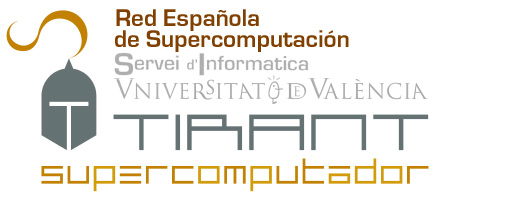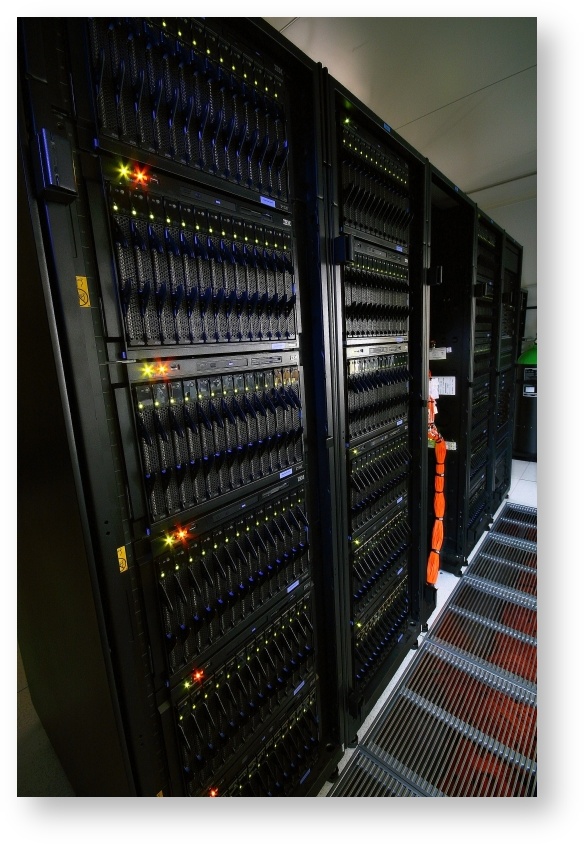(EN) SUPERCOMPUTATION RESOURCES IN THE UV - TIRANT

What is the Spanish Supercomputing Network?
The Spanish Supercomputing Network was inaugurated in March 2007, due to the need to increase the computing capacity that serves the scientific community. As a result of this need, an update of the MareNostrum supercomputer was carried out , in which the JS20 blades were replaced with JS21 blades, both from IBM, thus doubling their computing capacity. The substituted blades were used to create a distributed structure of Supercomputers in different locations of the Spanish geography.
Half of said blades was used to expand Magerit, the supercomputer belonging to CeSViMa (UPM). The rest was distributed, in equal parts, to create the nodes of the universities of Cantabria, Malaga, Valencia, Zaragoza and the Institute of Astrophysics of the Canary Islands (IAC). In this way, the RES is formed by the following supercomputers:
- MareNostrum at the BSC (Barcelona Supercomputing Center)
- Magerit at the CeSViMa (Polytechnic University of Madrid, Madrid)
- Altamira at the IFCA (University of Cantabria, Cantabria)
- LaPalma at the Institute of Astrophysics of the Canary Islands
- Picasso at the University of Málaga
- Tirant at the University of Valencia
- CaesarAugusta at the BIFI (University of Zaragoza)
Subsequently, Atlante , at the Technological Institute of the Canary Islands and MinoTauro , would join a system with GPUs in the BSC. Currently, the extended RES is a Singular Technical Scientific Infrastructure ( ICTS ) distributed. The updated information of its members and capacities can be consulted in the following link .
What is the supercomputer in the Universitat de València?
 In the Universitat de València, the machine is called Tirant, in honor of the protagonist of the Valencian novel Tirant lo blanc , written by Joanot Martorell in 1490.
In the Universitat de València, the machine is called Tirant, in honor of the protagonist of the Valencian novel Tirant lo blanc , written by Joanot Martorell in 1490.
In November 2012, MareNostrum suffers a second update, becoming a system of 1 PFlop / s (1 Peta Flop). As a consequence, all the nodes of the RES are updated and Tirant has a configuration of 2048 PowerPC 970+ cores and 4 TB of distributed RAM, with a peak power of 18.8 TFlops / s.
In July 2017, MareNostrum is updated again and now has 11 PFlop / s, so in July 2018, after some updating works of the Burjassot Data Processing Center, Tirant v3 starts up .
The new system consists of 336 nodes, each with two Intel Xeon SandyBridge E5-2670 processors at 2.6 Ghz and 32 GB DDR3 RAM (5376 cores). This gives the new Tirant 111.8 Tflop / s of performance and 10 TB of distributed memory. For the first time, Tirant mounts a storage system based on Luster, which provides 283 TB, enough for the storage needs of most users.
These supercomputers are accessible by any researcher, distributing the calculation time between the RES, which in the case of Tirant has 50%, and the institution that receives it, which has the remaining 50%.
Who can access Tirant?
In principle, any researcher from the Valencian Community can make a request for calculation hours for 50% of Tirant. In addition, they can request time of 50% assigned to the RES, following the forms collected on the web of the RES in the BSC.
Access protocol
- Each activity request to be developed in Tirant must be submitted by a researcher (Researcher Responsible for the activity) who must be a member of a current research project. Said project must be financed by an institution of international, national or regional scope, after public competition in a publicity, transparency, objectivity and competitive competition regime.
- The application form will include the following information:
- A description of the activity to be developed in Tirant . In particular, the relationship with the global scientific project in which the proposed activity is framed must be specified, including the reference number of the aforementioned project.
- A justification that this activity requires access to Tirant .
- A brief CV of the Researcher Responsible for the activity or, where appropriate, the Principal Investigator of the scientific project in which it is framed.References to the most relevant articles in the last five years will be included.
- A technical description of the software and the required resources to Tirant .
Evaluation process
Once the request for calculation hours has been completed and sent, it will be evaluated by a committee of 5 scientists who will determine whether or not their project can be executed on the machine of the Spanish Supercomputing Network, Tirant . For this, the following criteria will be used:
- Quality of the global scientific project in which the activity is framed (20%).
- Importance of the proposed activity, as well as the calculations made in Tirant to achieve the project objective (30%).
- Scientific credentials of the applicant research group (10%).
- Previous experience in the calculation of high benefits (10%).
- Real need of a supercomputer to carry out the calculations (20%).
- Technical convenience of the proposed activity to the architecture of Tirant (10%).
Obligations of the user
- Send to the Access Committee an electronic copy of those publications (articles, conference proceedings, etc.) based on results obtained thanks to the use of Tirant resources.
- Explicitly mention such use in said publications (eg, section acknowledgments).
- Follow-up of the rules of use of Tirant , and of the security and confidentiality policies of the RES.
- Guarantee that the results obtained using Tirant will not be used for profit, and that they will be usable only under the terms of Public Research.
- Provide the Access Committee with any additional information or documentation (videos, multimedia presentations, etc ...) to be used as material to disseminate the activities developed in Tirant .
Access requests
Access to the service is managed through an Access Committee, composed of scientists responsible for assessing each of the access requests and planning access to available resources. The resources are assigned for a period of 4 months, after which it is necessary to submit a new access request. The chosen model mimics the one that currently exists in the BSC, which has amply demonstrated its validity. The opening and completion of the deadlines for submitting applications will be duly published both on the Tirant website and on the scientific calculation users of the UV.
Request models for calculation hours
To make the calculation hours request, you must fill in the model that corresponds to your needs. There are two models available: calculation time request for a new project or request for continuation of an existing project, which for any reason needs more calculation hours.
Instructions for completing the forms
The forms are PDF files that must be completed. We recommend that Acroread be used. Once all is filled out, you must send it attached by mail to tirant@uv.es or follow the Acroread instructions after "Send form". Remember that there are two versions, one for new projects and another to request a renewal of a currently approved project.
Guided visits to our facilities
The Universitat de València allows guided visits to the installations of the Tirant supercomputer. The visit allows to know better the Spanish Network of Supercomputing and the operation of the node of Valencia.
Due to the recent construction of the new Data Processing Center (CPD) of the Universitat de València, the Tirant supercomputer has been moved to a new location, which forces us to make some changes in the visits. Please, although you have already come other times, review the new requirements.
The visit lasts approximately 1 hour and 30 minutes and consists of two parts, an introductory talk and a physical visit to the CPD. Consider the following:
- The number of visitors may not exceed 30, due mainly to the capacity of the CPD. For the physical visit, smaller groups of 10 people will be made. The rest of the visitors will wait outside the enclosure to be able to enter. If the visitors are minors, they will be accompanied by at least two teachers, so that they are not left unsupervised at any time.
- It is not allowed to enter food or drink to the CPD.
- It is not allowed to touch any computer component.
- There will be no visits in July and August, due to the vacations of the personnel in charge of them.
If you are interested in making a visit, please contact us at the following email address: res_support@uv.es providing the following information:
- Name and surnames of the teacher responsible for the group.
- DNI of the teacher responsible for the group.
- Educational Center of Origin
- Level of studies of visitors.
- Number of expected visitors
- Proposed dates for the visit.
| Rev: | 2018 / 06 |
| Lang. | |
| +Info | |
| Form.: | |
|
SERVEI D'INFORMÀTICA - UNIVERSITAT DE VALÈNCIA